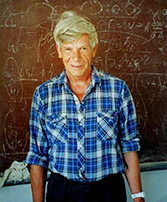Magnetic skyrmions (MS) are topologically protected configurations of local magnetization, observed, e.g., in non-centrosymmetric magnets with Dzyaloshinskii-Moriya interaction. In thin films MS arrange to 2D skyrmion crystals (SkX) [1]. The twisted character of skyrmionic configurations complicates an analysis of elementary excitations in such systems. We develop a novel approach that...
In this contribution an application of two techniques for resummation of asymptotic series namely Borel-Pade technique and Borel-Leroy technique with conformal mapping to the case of a model with multiple coupling constants will be discussed and the results of application of these methods to the $O(n)$-symmetric $\phi^{4}$ model with a real antisymmetric tensor order parameter will be presented.
The number of particles created in a resonant cavity is known to grow linearly at large evolution times [J. Math. Phys. 34, 2742 (1993)]. Employing the Schwinger-Keldysh diagrammatic technique, I show that nonlinear interactions generate nonzero quantum averages and enhance this number. For simplicity, I discuss a $\lambda \phi^4$ massless scalar field in a cavity with perfectly reflecting...
Quantum field perturbation theory is widely used in theoretical physics. This gives excellent results in weak interaction models (e.g. QED). Otherwise, a few known first terms of such a series are not enough and additional information is needed. This report is devoted to models of statistical physics and critical phenomena using the renormalization group (RG) approach.
Traditionally,...
The field theoretic renormalization group is applied to the strongly nonlinear stochastic advection-diffusion equation. The turbulent advection is modelled by the Kazantsev–Kraichnan “rapid-change” ensemble. As a requirement of the renormalizability, the model necessarily involves infinite number of coupling constants (“charges”). The one-loop counterterm is calculated explicitly.
The...
Using a simple model of self-organized criticality, we study interplay between intrinsic dynamics and external disturbances that affects the resulting critical behaviour. The model is Hwa-Kardar “running sandpile” that is a stochastic equation for a coarse-grained field that describes evolution of anisotropic system [Phys. Rev. Lett. 62, 1813 (1989); Phys. Rev. A 45, 7002 (1992)]. Using the...
Diffusion-limited reactions are famous examples of nonlinear statistical systems and can be observed in various chemical, biological and physical problems. For these systems in low space dimensions, the usual description by means of kinetic rate equations is not sufficient and the effect of density fluctuations has to be taken into an account. Using perturbative renormalization group we study...
We investigate massive models of quantum field theory of scalar field in logarithmic dimensions in Euclidean space. The Schwinger-Dyson equation and non-trivial solution for mass are considered in the paper.
The Schwinger-Dyson equation has the form:
D−1=Δ−1−Σ
where D is a full propagator, Δ is a bar propagator, Σ is a self-energy operator. In the minimal subtraction (MS) scheme it...
We study a self-organized critical system under the influence of turbulent motion of the environment. The model addresses two unusual scaling regimes (types of critical behaviour) predicted by the field-theoretic renormalization group analysis for a self-organized critical system with turbulent motion of the environment. The system is modelled by the anisotropic stochastic equation for a...
The phenomenon of self-organized criticality (SOC) consists in the emergence of scaling in open nonequilibrium systems with dissipative transport. Unlike equilibrium systems that arrive at critical states when control parameters approach their critical values, systems with SOC evolve to critical states due to their intrinsic dynamics. Such systems are widespread in nature with SOC being...
Quantum dynamics of boson gas near the Bose-Einstein condensation transition has attracted considerable interest recently. While the static critical behavior of the system is generally believed to belong to the universality class of the $XY$ model, [or $O(2)$ model] with the corresponding critical exponents, there is no consensus about its dynamic critical behavior and, in particular, the...
Critical dynamics of fluids is described by continuum field equations, to which a stochastic noise is added to capture thermal and hydrodynamic fluctuations. This study reveals the interplay between critical ordering and developed turbulent flows. B-model coupled to the random Gaussian velocity field, which mimics Kolmogorov turbulence, is investigated on large scales via the functional...

